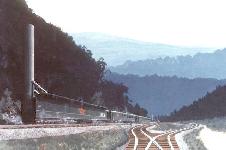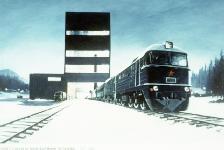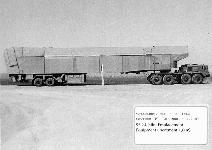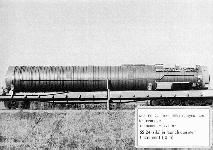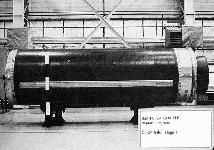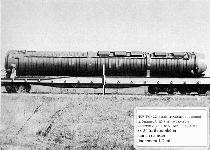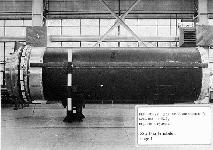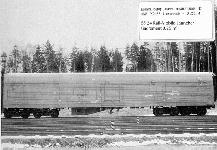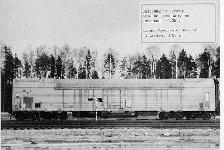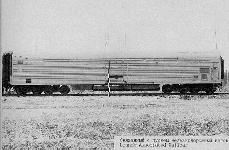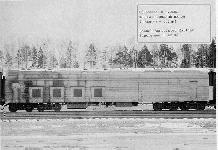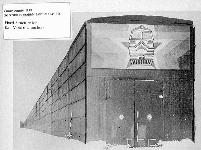RT-23 / SS-24 SCALPEL
Comparable in size and concept to the US Peacekeeper, the SS-24 is cold-launched with 10 warheads. The missile is deployed both as rail-mobile and silo-based. The silo-based SS-24 was intended to replace the SS-19 Stilletto in the Russian strategic inventory. The SS-24 rail missile systems is subject to elimination under the provisions of the START-II Treaty.
The RT-23UTTh is a solid-propellant missile with three stages within a constant diameter body. The first stage of the silo-based missile uses a rotating nozzle, whereas the railway�based version is equipped with a fixed nozzle partially inserted in the motor combustion chamber. The engines of the second and third stages deploy extendable nozzles during flight to increase the motor's specific impulse without the need to increase of the overall dimensions of the missile. During the first stage flight control is attained through deflection of the sustainer nozzle, and during the second and third stage by deflecting the combat stage and by fairing-mounted aerodynamic vanes.
Both silo-based and rail-mobile missiles have an autonomous inertial guidance system using an onboard digital computer. The silo-based system uses a two-package block of control instruments made of radiation-resistant electronic elements. The railway-based missile has only one-package block of control instruments.
A total of 10 warheads [each with a yield of 550 KT], a post-boost vehicle with a guidance/control system and a propulsion system are inside the nose cone. The guidance/control system provides a CEP of 500 meters according to unofficial Russian estimates, which gives the missile a hard-target-kill capability. The missile is deployed in a transport-launching canister from which it is launched through the mortar start technique. To conduct a railway launch the sliding roof of the car opens, the container is erected and the missile is launched with the help of a solid propellant gas generator. The missile can be launched from any point of the route.
The length of the two versions are the missile were determined by the dimensions of the silo or the railway launcher. The silo-based missile therefore has a nose cone tip flap that is activated when the launch is initiated while the railroad based missile has a folded nose cone that is extended when the launch is conducted.
The creation of the RT-23 UTTh was the culmination of a long-term effort to create a solid-propellant ICBM for multiple basing modes which was initiated on 13 January 1969.
- 15Zh44 - SS-24 PL-4 The difficulties with which the developing institute KB Yuzhnoye (OKB-586) was confronted during the development of the railway-based SS-24 led to a redefinition of the task on 23 July 1976. Only a silo-launched version of the RT-23 was considered. The preliminary design was completed in March 1977 but it was considered unsatisfactory, and in December 1979 a second design with an improved propulsion system and a front end was finished. The new design provided using reentry vehicles that were identical to that of the R-36M / SS-18 missile. The suspended activities to build a railway based RT-23 (15Zh52) missile were resumed, and this design was finished in June 1980. The flight-design tests of the silo-launched RT-23 (15Zh44) began on 26 October 1982. As a result of several failures during the flight-tests, this version was cancelled on 10 February 1983 by the Soviet Defense Ministry.
- 15Zh52 - SS-24 Mod-0 On 09 August 1983 a further effort to develop a silo, railway and road-mobile missile designated as RT-23UTTh was approved, but the road-mobile stationing mode was subsequently abandoned. The tests of the railway based RT-23 (15Zh52) were successfully completed in April 1985, and in November 1987 it was experimentally adopted.
- 15Zh61 - SS-24 Mod-1 The RT-23UTTh tests of the railroad SS-24 Mod-1 version (15Zh61) that is almost identical to the 15Zh52 began on 27 February 1985 and were finished in December 1987 The deployment of these missiles started on 28 November 1989, and the first regiment with railroad-based missiles was put on alert on 20 October 1987. Altogether 36 railway-based RT-23UTTh missiles were initially deployed. They were deployed in three garrison areas: 12 launchers at Kostroma (400 km east of Moscow), 9 launchers at Bershet (1,250 km east of Moscow), and 12 launchers at Krasnoyarsk in Siberia. The Military Railroad Missile Complex (Boyevoy Zheleznyy Raketnyy Kompleks BZhRK) consists of three launch cars [each with a single missile], a command and control car, cars for personnel, and several diesel locomotives. The rail-mobile version could operate on any Soviet rail line that was unobstructed by overhead electrical power lines, a total of 145,000 km of track.
- 15Zh60 - SS-24 Mod-2 The silo-based version (15Zh60) known as SS-24 Mod-1 was tested from 31 July 1986 through November 1988. The deployment of these missiles in silos formerly occupied by SS-17 Sego ICBMs, started on 28 November 1989, and the first regiment of silo-based missiles was activated on 19 August 1988. Altogether 56 silo-based RT-23UTTh missiles were initially deployed, with 10 at Tatishchevo in Russia and 46 at Pervomaysk in Ukraine.
The US Defense Department stated in September 1991 that production had ended with approximately 90 missiles deployed. A total of 46 silo-based RT-23UTTh missiles located in Ukraine were phased out and dismantled in compliance with the provisions of the START-1 treaty. They were denuclearised and their warheads have been transferred to Russia. By 1994 most of the rail-mobile systems remained in garrison due to lack of funding. By April 1997 10 silo-based and 36 railway based RT23-UTTh missiles were still deployed on Russian territory. Following Russian ratifiication of the START-2 treaty in early 2000, all RT-23 UTTh missiles are subject to dismantling.
With the breakup of the Soviet Union in 1991, most design and production facilities for the SS-24 belonged to Ukraine. Ukraine had no interest in continuing to produce these ICBMs, and the production line was closed in 1995.
It has been suggested that these rail-mobile land-based missiles, which have been parked in their garrisons, may be placed back on patrol in response to American missile defense and associated arms control initiatives.
Specifications | ||||
|
R & D |
Mod- |
Mod-2 |
Mod-1 |
|
|
DIA |
SS-24 |
SS-24 |
SS-24V |
SS-24 |
|
NATO |
Scalpel |
Scalpel |
Scalpel |
Scalpel |
|
Bilateral |
RS-22B |
RS-22A |
RS-22V |
|
|
Service |
RT-23 |
RT-23 |
RT-23 UTTKh |
RT-23 UTTKh |
|
OKB/Industry |
15Zh44 |
15Zh52 |
15Zh60 |
15Zh61 |
|
Design Bureau |
SKB-586, NPO Yuzhynoy Acad. V. F. Utkin |
SKB-586, NPO Yuzhnoye Acad. V. F. Utkin |
SKB-586, NPO Yuzhnoye Acad. V. F. Utkin |
SKB-586, NPO Yuzhnoye Acad. V. F. Utkin |
|
Approved |
7/23/1976 |
6/1/1979 |
8/9/1983 |
8/9/1983 |
|
Years of R&D |
1/1969 ?3/1977 |
11/1982 - 1987 |
1983 - 1989 |
1983 - 1989 |
|
Engineering and Testing |
1985-87 |
|||
|
First Flight Test |
10/26/82 Failure, 12/1982 Success |
4/ /1984 |
7/31/1986 |
2/27/1985 |
|
IOC |
canceled |
10/20/87 |
8/19/1988 |
12/1987 |
|
Deployment Date |
Canceled |
11/ /1987 |
11/28/1989 |
11/28/1989 |
|
Type of Warhead |
MIRV |
MIRV |
MIRV |
MIRV |
|
Warheads |
10 |
10 |
10 |
10 |
|
Yield (Mt) |
0.55 |
0.35 -0.55 |
0.35 -0.55 |
0.3 -0.55 |
|
Payload (t) |
4.05 |
4.05 |
4.05 |
4.05 |
|
Total length (m) |
23.3 |
23.4 - 23.8 |
18.8 - 23.4 |
23.3 |
|
Total length w/o warhead (m) |
18.8, 19 |
19 |
19 |
19 |
|
Missile Diameter (m) |
2.4 |
2.4 |
2.4 |
2.4 |
|
Launch Weight (t) |
104.5 |
104.5 |
104.5 |
104.5 |
|
Range (km) |
10,000 |
10,000 - 11,000 |
10,100 -11,000 |
10,100 - 10,450 |
|
CEP (m) (Russian Sources) |
500 |
500 |
500 |
500 |
|
CEP (m) (Western Sources) |
150-250 |
150-250 |
150-250 |
150-250 |
|
Basing Mode |
Silo |
Silo |
Railroad |
|
|
Number of Stages |
3 |
|
|
Canister length (m) |
21.0 - 22.4 |
|
|
Canister length w/o Front meters (m) |
19.4 |
|
|
Canister diameter (m) |
2.7 |
|
|
Booster guidance system |
Inertial autonomous |
|
|
1 Stage |
2nd Stage |
3rd Stage |
Bus Stage |
|
|
Length (m) M1 |
9.7 |
4.8 |
3.6 |
|
|
Length (m) M2 |
9.5 |
|||
|
Body diameter (m) |
2.4 |
2.4 |
2.4 |
2.4 |
|
Fueled weight (t) M2 |
52.5 |
|||
|
Fueled weight (t) M1 |
53.7 |
|||
|
Dry weight (t) |
||||
|
Design Bureau |
||||
|
Solid Motor Designation |
15D305 |
15D339 |
||
|
Propellants |
Solid Propellant |
Solid Propellant |
Solid Propellant |
|
|
Burning time (sec.) |
||||
|
Solid Motor Thrust Sea Level/Vacuum (Tonnes) |
?/210 |
107 |
21 |
|
|
Specific Impulse (sec.) |
||||
|
Hardness |
|
|
Launching Technique |
Cold |
|
Deployed boosters |
56 |
|
Test Boosters |
|
|
Warheads Deployed |
560 |
|
Training Launchers |
|
|
Space Booster Variant |
Yes, concept only Space Clipper |
Deployment Sites
|
START |
Locale US-Designation |
|
Kostroma |
Kostroma |
|
Pervomaysk |
Pervomaysk |
|
Tatishchevo |
Tatishchevo |
|
Bershet |
Bershet |
|
Krasnoyarsk |
Krasnoyarsk |
Sources and Resources
- Russian Strategic Nuclear Weapons, Pavel Podvig, ed., IzdAT, Moscow, 1998, 492 pp. (in Russian). Authors: Oleg Bukharin, Timur Kadyshev, Eugene Miasnikov, Pavel Podvig, Igor Sutiagin, Maxim Tarasenko, Boris Zhelesov
- SS-24 Scalpel Railway's missile complex




